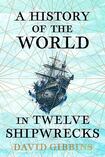
We have an endless fascination with shipwrecks, the drama of sudden disaster, speculation on the causes, excitement when a shipwreck is discovered and, most of all, the allure of sunken treasure.
This is an inviting, eclectic book loosely based on 12 shipwrecks, ranging from a Bronze Age wreck to a ship sunk during the Battle of the Atlantic. It is a cornucopia of information and stories, lengthy but readable, drawing in a wide net of maritime figures and explorers, although calling it a history of the world is overstating it a bit.
David Gibbons, a maritime archaeologist and experienced deep-sea diver, offers chilling descriptions of this hazardous activity, balanced by the thrill of finding a wreck that has lain undisturbed for centuries. A huge draw is the treasure to be recovered, and here we learn of cannons, gold coins, amphorae, candlesticks, letters and two Rembrandt paintings being shipped from Amsterdam to Genoa. They never arrived.
The author argues that marine archaeology should be treated the same as that on land with similar professional standards and restrictions. The question is: when does exploration of wrecks become looting? Robert Ballard, discoverer of Titanic, has campaigned strongly against the latter. Yet this book only occasionally refers to the issue of who keeps valuable artefacts recovered from sunken ships.
Gibbins concedes the shadow of death lingers over every shipwreck, many believing such wrecks should be left untouched. Henry VIII’s flagship, the Mary Rose sank in 1545 off Portsmouth and when discovered 400 years later the wreck contained several skeletons trapped inside.
The 12th shipwreck in the book is the SS Gairsoppa, torpedoed off the coast of Ireland in 1941. At City Quay in Dublin stands a memorial to the many Irish merchant seafarers who died during the second World War while bringing us essential supplies.
Among the names is Capt Thomas Aplin, master of the aged City of Waterford, sunk after a collision in the Atlantic, also in 1941. The crew survived and transferred to the Walmer Castle, which was then sunk by a German bomber, killing Aplin and many of his crew. His son Tom was born after the disaster and lives in Dublin; he never met his father. Shipwrecks come at a high human cost.














